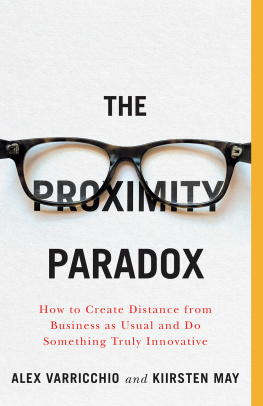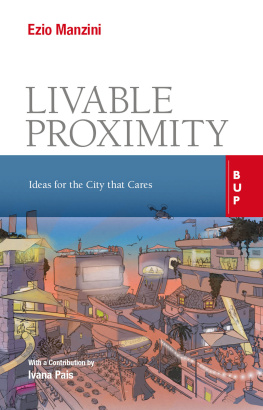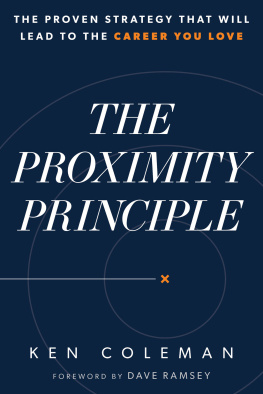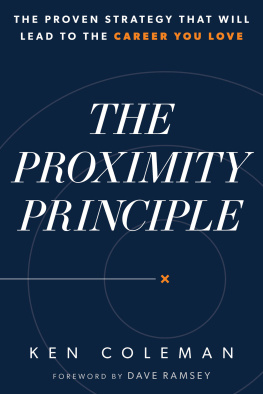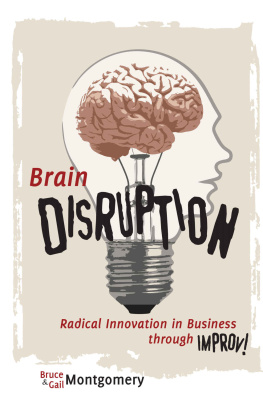The Proximity Paradox
How to Create Distance from Business as Usual and Do Something Truly Innovative
Alex Varricchio and Kiirsten May
Contents
The Proximity Paradox is both provocative and prescriptive. It will challenge your industry experience, best practices, and team alignment. In our digital economy where creativity and innovation are in constant demand, business leaders need a new approach for meeting their client needs. The Proximity Paradox helps you see what you are doing wrong and how to fix it. A must-read for all agency and marketing executives.
MK Marsden, three-time global CMO, managing partner at Touchpoint Strategies and board practice leader at Avasta
The Proximity Paradox isnt just a must-read for anyone in business today, it should be your manual for continually unleashing innovation in your teams and within yourself. Their approach is pragmatic, challenging, and, most importantly, hopeful.
Matt Johnston, Johnston Group
On almost every page of this book, I found myself nodding in agreement, taking notes, or dog-earring the edge. It brings up so many points that I will now be putting in to practice in my own business. Big thank you to Kiirsten and Alex for putting this together. Its a must-read for creatives and entrepreneurs.
Phoebe Cornog, co-owner/founder, Pandr Design Co.
I have read a ton of famous business books and The Proximity Paradox is one of the better ones. Its practical, relatable, and immediately applicable. I think the Proximity Paradox is a great concept, true in many ways. It gave me three ideas that I will try with my employees and a new business idea.
Steve Alexander, operations manager, AGI Westfield
I read The Proximity Paradox as a neuroscientist, psychologist, and business owner and from all three perspectives feel like its great! Its like applied neuroscience without all the jargon of how the brain works. Instead its a practical guide to taking a step back from some of the biases our brain naturally makes when we are too close or experienced in an area. I felt inspired to try these strategies with my own company and at other times affirmed with some of the strategies I already use. The examples throughout were poignant and I even caught myself laughing out loud on the streetcar. This book is a must-have for any creatives, business owners, or academics who want to stay relevant in their field for years to come.
Mandy Wintink, PHD, RYT, life coach, director,
Centre for Applied Neuroscience Inc.
Dedicated to our families, friends, and the
creative folk whose weird stories fill these pages.
A graphic designer is invited to paint a mural on the side of an old building in a rough end of town. She collaborates with a group of artists to turn four storeys of tired brick into a contemporary work of art. When the mural is complete, the neighborhood throws a party to celebrate the first of what they hope will be many rejuvenations to the area. The graphic designers boss reads about the mural in the news and asks her, Why cant you create something like that around here?
Weve seen things like this happen again and again for more than ten years. As advertising agency people, we have the opportunity to work with a lot of creative types. Were not just talking about designers and artists; were talking about people with the ability to solve old problems in new, imaginative ways. Advertising agencies and marketing departments attract thousands of these types. Yet its rare to see a creative person unleash his or her full potential at work.
We call this effect the Proximity Paradox, and thats what this book is all about. Proximity is the effect that shackles creativity, dilutes innovation, steers brave people down safe roads, and pushes leading-edge companies to the back of the pack. Its what was blocking your view when a competitor blindsided you. Its what eventually wore down your bold, inventive younger self, and its what is still wearing you down today.
Whats paradoxical about proximity (in the literary sense of paradox) is that many of us dont view it as a hindrance. We view it as credibility and call it expertise. We set up systems to reinforce it, we teach it, and we pass it on to future generations.
The Proximity Paradox is slowly killing original thinking and, as a result, our ability to remain relevant.
We live in a world where we must innovate to survive
There has never been a more important time for people and organizations to break free from the chains of proximity. According to a report by Mark J. Perry at the American Enterprise Institute, only twelve percent of Fortune 500 firms that existed in 1955 still existed in 2016:
Its reasonable to assume that when the Fortune 500 list is released 60 years from now in 2076, almost all of todays Fortune 500 companies will no longer exist as currently configured, having been replaced by new companies in new, emerging industries, and for that we should be extremely thankful. The constant turnover in the Fortune 500 is a positive sign of the dynamism and innovation that characterizes a vibrant consumer-oriented market economy, and that dynamic turnover is speeding up in todays hyper-competitive global economy.
Its impossible for a company to adopt dynamism and innovation when the Proximity Paradox is at work. We need to restructure our teams and processes so our people can adopt the style of thinking that spurs new ideas.
Its harder than ever to win over new customers
The pressure to compete and attract customers is high. American investor Bill Gross says a product must be ten times better than the competition in order to convince a potential customer to switch. Organizations that only look to do marginally better than their competitors will never achieve the customer base they need to win.
We need to create distance from the old rival down the street and instead measure ourselves against a formidable new opponent. Its the only way we can really challenge ourselves to create the exponentially better product or service we need to acquire new customers.
The jobs of creative people are being commoditized in business
In an article she wrote for Quartz, Sarah Kessler reported that new technology allows companies to do away with hiring and just buy marketing services online. Platforms like Fiverr have dragged many creative services into the sewer of quality and price. Organizations no longer need to hire writers, designers, developers, or even advertising agencies they can get their basic marketing work completed online for a few bucks in a few days. People who have spent years developing their craft can no longer earn a living doing great work they must do fast work cheaply.
But people who can offer big-picture thinking, strategic services, and innovative ideas cannot be commoditized, and they will continue to find top jobs and top wages. We need to help people in commoditized industries develop these skills so that they arent easily replaced.
Who are we to help?
Weve both had the opportunity to see inside hundreds of different organizations and learn about their people, products, and businesses. Weve worked with such industries as agriculture, manufacturing, construction, trade brokering, logistics, food services, real estate, law, accounting, health care, education, research, arts, and tourism, as well as with public utilities, the charitable sector, and local and regional governments.

